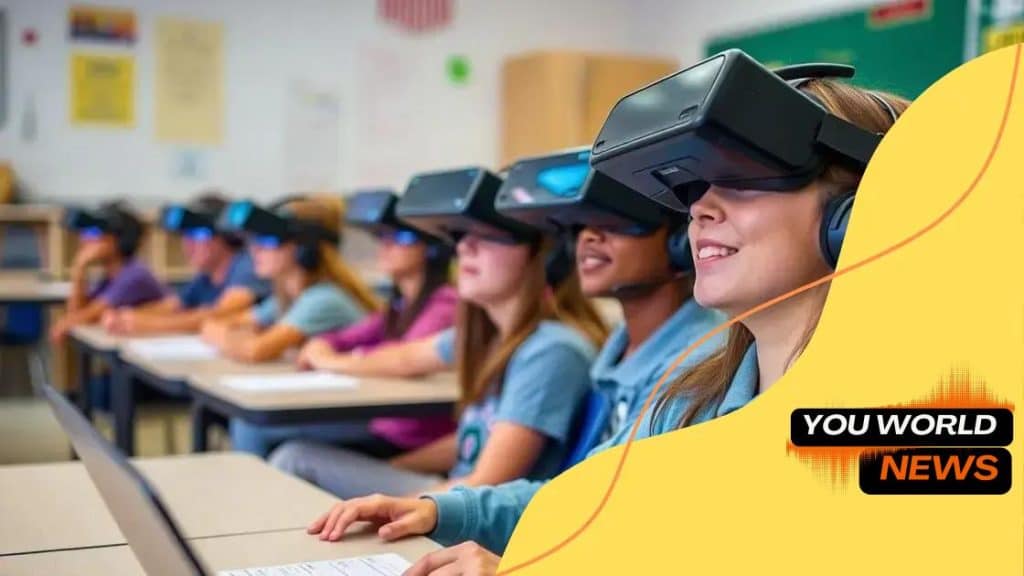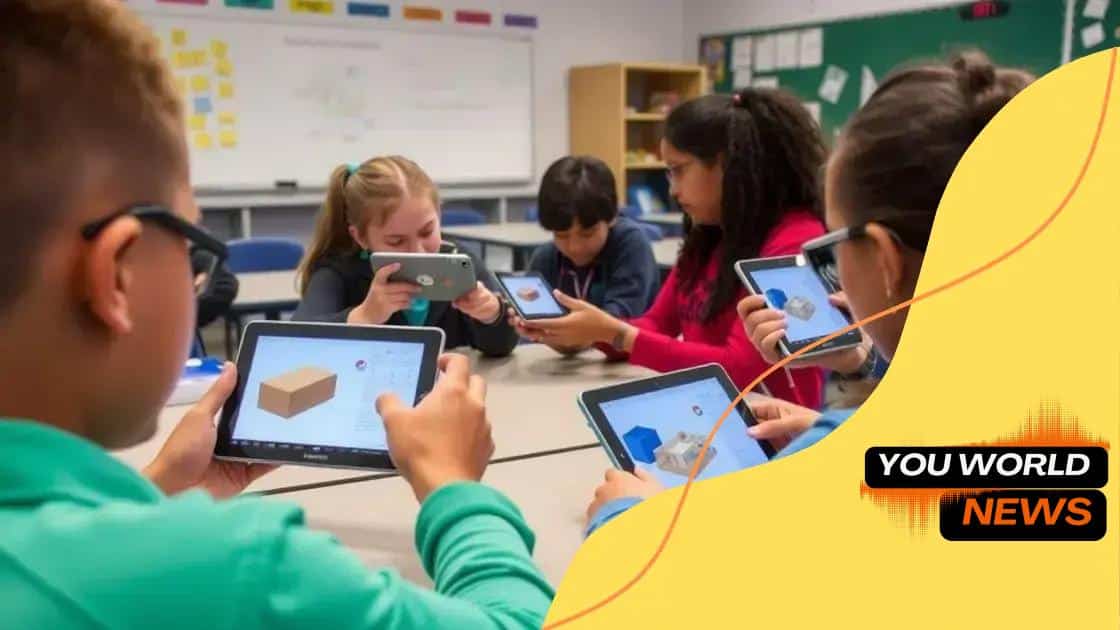How AR is being used for hands-on learning experiences

Augmented reality (AR) in education enhances learning experiences by providing interactive, engaging, and personalized educational tools that support diverse learning styles and promote collaboration among students.
How AR is being used for hands-on learning experiences is changing the way we engage with education. Imagine students exploring complex subjects through interactive digital overlays. How cool is that?
What is augmented reality in education?
Augmented Reality (AR) in education is a technology that overlays digital information onto the real world. This allows students to visualize complex concepts in a way that is engaging and interactive. AR transforms traditional learning into a more dynamic experience.
With augmented reality, students can interact with 3D models, visualize scientific phenomena, and even take virtual field trips. This hands-on approach makes learning enjoyable and memorable.
Benefits of Augmented Reality in Education
Using AR in the classroom has several advantages:
- Enhances understanding of complex subjects.
- Increases student engagement and motivation.
- Provides personalized learning experiences.
- Encourages collaboration among students.
Students can explore historical sites or anatomical structures without ever leaving the classroom. For instance, AR applications make it possible to see the solar system right above their desks or dissect a virtual frog.
Moreover, AR technology supports different learning styles. Visual learners benefit from seeing information in 3D, while kinesthetic learners thrive with hands-on activities. This adaptability allows teachers to cater to each student’s unique needs.
Examples of Augmented Reality Applications
Many schools have started using AR tools to enhance their curriculum. Some popular applications include:
- Google Expeditions: Offers virtual reality and AR experiences for immersive classroom explorations.
- Merge Cube: A handheld device that students can use to interact with digital objects.
- Quiver: An app that brings coloring pages to life with AR.
These tools encourage active participation and make learning more engaging. Students are not just passive recipients of information; they become explorers and innovators.
Incorporating augmented reality into education fosters an environment where learning is both fun and impactful. By breaking down the barriers of traditional teaching methods, AR is paving the way for a new era in education.
Benefits of AR for hands-on learning
Benefits of AR for hands-on learning encompass a wide range of advantages that enhance the educational experience. By integrating AR into education, teachers can create interactive lessons that engage students in a more profound way.
This immersion fosters a better understanding of subjects that may be difficult to grasp through traditional methods. Students can visualize and manipulate objects in a virtual space, helping them retain information longer.
Key Advantages of Using AR
- Interactive Learning: Students actively participate in their education through hands-on experiences.
- Enhanced Engagement: AR captures students’ attention, making learning more enjoyable and memorable.
- Real-World Applications: Students can see how concepts apply in real-life contexts.
- Diverse Learning Styles: AR caters to visual, auditory, and kinesthetic learners, ensuring everyone benefits.
Implementing AR tools in the classroom leads to a more dynamic learning environment. For example, when studying anatomy, students can explore the human body in 3D. This visual aid creates a deeper understanding that textbooks alone cannot provide.
Moreover, students can collaborate on AR projects, which promotes teamwork and critical thinking skills. They can work together to solve problems or create presentations using AR effects.
The ability to manipulate objects in an AR setting also helps develop fine motor skills and spatial awareness. This hands-on involvement engages students in a meaningful way and often sparks their curiosity.
Encouraging Creativity and Innovation
Augmented reality not only supports the learning of existing subjects but also encourages creativity and innovation. Students can create their own AR experiences, fostering an environment where they can express their ideas freely.
This creativity extends beyond the classroom, as students learn to think critically and approach problems from different angles. By utilizing AR technology, they become active participants in their own learning journey.
Examples of AR applications in classrooms

Examples of AR applications in classrooms are transforming the educational landscape. These tools make learning interactive and give students the opportunity to engage with materials in new ways.
One popular application is Google Expeditions. This app allows students to take virtual field trips to places around the world. They can explore ancient ruins or dive deep into the ocean—all from their classroom. This immersive experience makes history and science exciting and accessible.
Interactive Learning Tools
Another notable example is Merge Cube. Students can hold a cube in their hands and see holographic images appear. They can manipulate these images, allowing them to visualize complex concepts like the solar system or human anatomy.
- Quiver: This interactive coloring app brings drawings to life. When students color a page, they can scan it with their device to see a 3D version come to life on the screen.
- AR Flashcards: These cards use AR to provide additional information and visuals. Students can point their device at a card to see a 3D model associated with the subject.
- Aurasma: This app enables users to create their own AR experiences. Teachers can design lessons that turn everyday objects into interactive learning tools.
Using these applications, teachers can create lessons that resonate with students. They can visualize math problems, explore historical events, or understand scientific concepts through engaging digital experiences.
Moreover, AR applications promote collaboration among students. Working together on projects with AR tools encourages teamwork and boosts communication skills. As they interact with these technologies, students become not only consumers of information but also creators.
These examples show how augmented reality is changing education. By providing unique learning experiences, AR tools help all students grasp complex subjects. The possibilities are endless, making learning more dynamic and enjoyable.
Challenges of implementing AR in education
Challenges of implementing AR in education are significant but can be overcome with careful planning. Even though augmented reality has many benefits, there are obstacles that schools must address to make this technology effective.
One major challenge is the cost of AR technology. Acquiring devices like tablets or AR headsets can be expensive. Many schools may not have the budget for such tools, limiting their ability to incorporate AR into the classroom.
Technical Issues
Another challenge is related to technology itself. Not all schools have the necessary infrastructure, such as reliable internet access and updated hardware, to support AR applications. This can lead to frustrating situations where students are unable to access the resources needed for their learning.
- Training for Educators: Teachers must be trained to use AR effectively. Without proper training, they may struggle to integrate this technology into their lessons.
- Classroom Management: Managing a classroom where students are using AR can be complex. Teachers need strategies to keep students focused and on task.
- Content Availability: There may be limited AR content available for certain subjects. Educators often have to create their own materials, which can be time-consuming.
Moreover, some students may find it challenging to adapt to new technologies. While many kids are tech-savvy, not all may feel comfortable using AR tools. This discomfort can hinder their learning experience.
Finally, there is the issue of equity. Not all students have the same access to technology at home. If AR is used for homework or projects, those without access to devices or internet connection may fall behind.
To truly benefit from augmented reality, schools must consider these challenges. By addressing financial constraints, training needs, and technical requirements, educators can create a more inclusive learning environment.
The future of AR in learning experiences
The future of AR in learning experiences looks promising and exciting. As technology continues to advance, more educational institutions are adopting augmented reality to enhance classroom engagement.
With its immersive capabilities, augmented reality is set to transform how students learn. Future classrooms may not rely solely on textbooks; instead, they will host a variety of AR tools to provide interactive lessons that captivate students’ attention.
Innovative Applications
New AR applications are emerging regularly. For instance, virtual labs can allow students to conduct science experiments in a safe, controlled environment. This means they can try things out without the risk of accidents or failures.
- Interactive Simulations: Students can engage with realistic scenarios in subjects like history, science, or even geography, providing a deeper understanding of the material.
- Personalized Learning: AR can adapt to each student’s pace, offering customized content that caters to their individual learning style.
- Accessibility: AR can bridge gaps for students with disabilities, offering unique ways to interact with and understand content.
In addition, the integration of AR into everyday lessons promotes collaboration. Students can work together on projects that utilize AR technology to create new learning experiences.
As AR becomes more commonplace, teacher training will also evolve. Educators will need to learn how to implement these technologies effectively. Professional development for teachers will focus on how to use AR tools creatively in their teaching.
The future will likely see increased partnerships between schools and tech companies. These collaborations can lead to the development of tailored solutions to meet educational needs. By innovating together, education and technology can create impactful learning experiences for students.
In conclusion, the future of augmented reality in education will hinge on continual advancements in technology. As AR tools become more sophisticated, they will redefine classroom experiences, ensuring that learning is engaging, interactive, and accessible for all.
FAQ – Frequently Asked Questions about Augmented Reality in Education
What are the main benefits of using AR in classrooms?
AR enhances engagement, promotes interactive learning, and caters to different learning styles, making education more effective.
What challenges do schools face when implementing AR?
Challenges include high costs, lack of infrastructure, and the need for teacher training to effectively use AR tools.
How can AR help students with different learning needs?
AR provides visual and hands-on experiences that can support various learning styles, allowing all students to engage with the material.
What is the future of AR in education?
The future of AR in education looks bright, with more innovative applications being developed that will enhance classroom experiences and facilitate collaboration.





